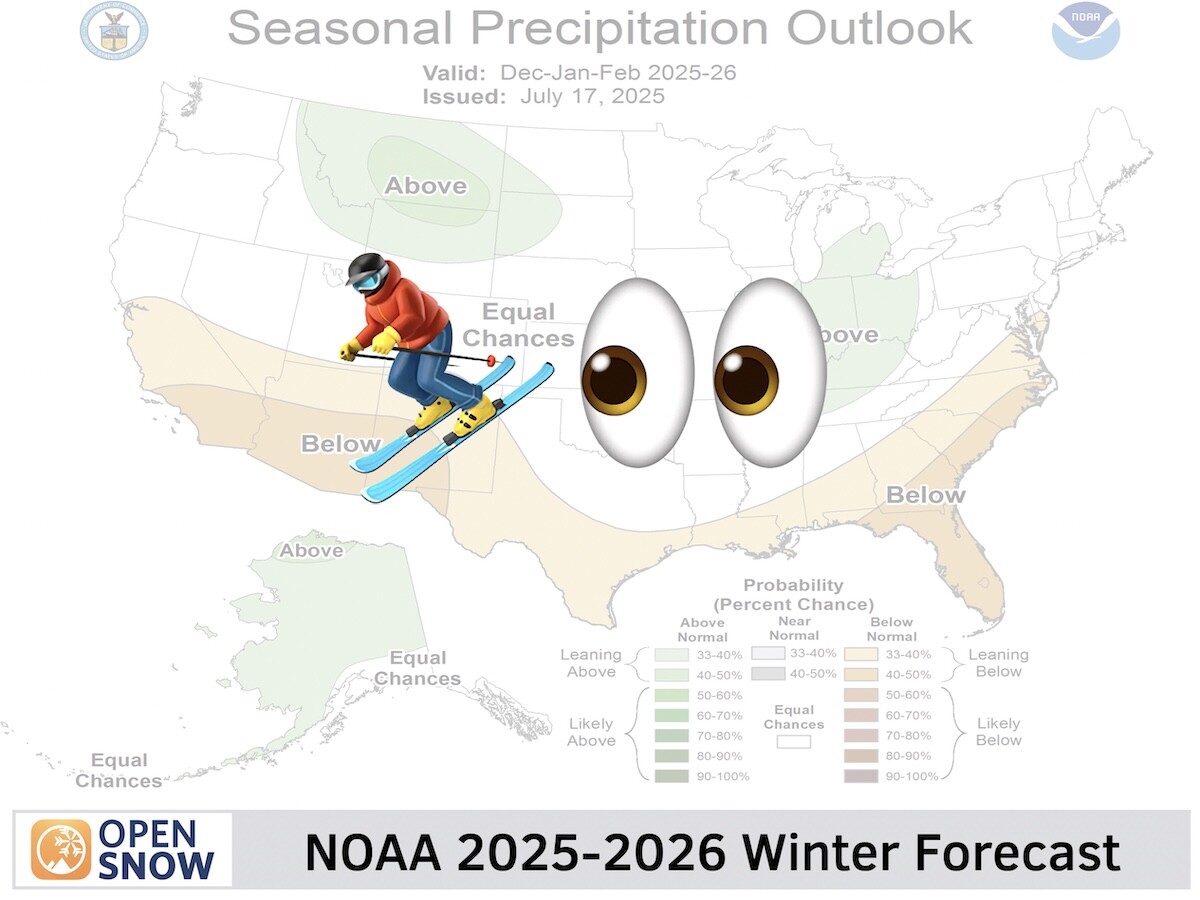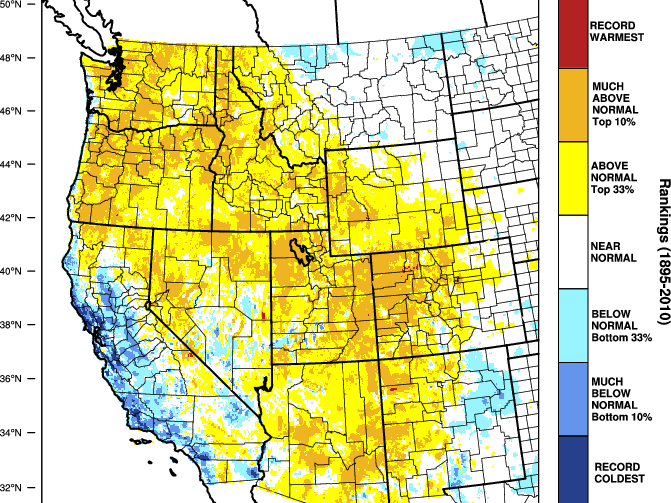News

By Alan Smith, Meteorologist Updated 3 months ago April 18, 2025
Spring Skiing, Explained

Spring is a wonderful time of year to hit the slopes. Base depths are near their climatological peak, while warmer temperatures and more abundant sunshine make skiing enjoyable in a different kind of way compared to mid-winter powder skiing.
Snow conditions during March and April are a lot different than mid-winter, and they also change more rapidly. At this time of year, new snow is not always the number one factor. Temperature, cloud cover, wind, elevation, slope aspect, and time of day are all significant factors that affect snow conditions.
Corn Snow, Explained
In the absence of storms during the springtime, the focus shifts from powder snow to corn snow.
According to the National Avalanche Center, corn snow forms during repeated melting and refreezing of the snowpack and involves large-grained, rounded crystals that create a supportable snowpack to ski on.
Corn snow makes for outstanding ski conditions – most would argue it's the next best thing after powder. For the best corn skiing conditions, it's all about timing melt/freeze cycles and skiing just when the top 2-3 inches have softened up. Clear skies and light winds are also optimal for corn skiing.
Let's take a look at the factors that can affect corn skiing...
Terrain and Slope Aspect
The direction a slope faces and how much sun it receives relative to surrounding slopes is one of the most important considerations when it comes to spring skiing.
- North-facing slopes receive the least amount of sun, which means these slopes hold onto soft snow and powder for a long period of time after a storm. But if firm conditions do develop on north-facing slopes, they are the last ones to soften up and may not soften up at all if the air temperature does not rise much above freezing.
- South-facing slopes receive the most amount of sun exposure and are the first slopes to enter melt/freeze cycles, typically starting in February. During the core spring months of March and April, south-facing slopes will soften up earlier in the day.
- East-facing slopes are the first to be hit by the sun in the morning and soften up earlier in the day as a result. In mid-winter, the sun doesn't impact east slopes as much due to cold temperatures and a weaker sun angle, but by March and April, east slopes warm up much more quickly and easily.
- West-facing slopes are slower to soften up as they are in the shade during the morning hours, before the sun hits these slopes in the afternoon. Once the sun does reach western slopes, they tend to warm up very quickly as sun exposure coincides with the warmest air temperatures of the day in the afternoon.
It helps to study a topo map of the area you will be skiing to get a general understanding of the slope aspects at a resort and to plan your days accordingly. Our map overlays have terrain contours to help identify slopes and you can also view lifts/runs at ski areas on these maps.

Tree cover is also an important consideration. All else equal, denser tree cover involving large conifers with thick branches will limit the amount of solar radiation that reaches the snow compared to open slopes.
Elevation
As seasonal temperatures begin to warm up in March and April, snow conditions become more elevation-dependent, especially at ski areas with large vertical drops.
Lower-elevation terrain tends to soften up more substantially in the afternoons due to warmer temperatures compared to higher-elevation terrain. Aspect still plays a role at lower elevations, however, with east and south-facing slopes softening up first.
Temperature and Solar Radiation
During December and early January, the sun is at its weakest point of the year and this is when days are also shortest. By the time March arrives, the days are much longer and the sun is also much stronger with more intense solar radiation reaching the surface of the earth.
Sunny periods during March and April impact snow conditions much more easily compared to mid-winter, even when the air temperature is below freezing. The sun is just that powerful at this time of year.
For optimal spring skiing conditions, you want to look for periods when low temperatures fall well below freezing (20s or teens ºF is optimal) and high temperatures rise above freezing (30s to low 40s ºF is best). This creates the melt/freeze cycle necessary for corn snow to form.
If high temperatures fail to rise above freezing but the sky conditions are sunny, then snow will typically still soften up on all but north-facing and shaded terrain, but it will take longer compared to days in which air temperature rises above freezing.
Cloud Cover
One thing that can negatively impact snow conditions in March and April is heavy cloud cover without new snow.
If cloud cover becomes thick and widespread and high temperatures are near to below freezing, this can prevent the snow from softening up, resulting in unpleasant firm and crusty conditions. If you get a day like this in the spring, then it's best to stick to groomers.
Cloud forecasts can be tricky as it's common in the spring to have days featuring a mix of sun and clouds. It usually doesn't take much sun at this time of year to warm up the snow, so even if our forecast shows 50-70% cloud cover, there's still a decent chance you'll get enough sun to soften things up a bit.
Also, thin/high cloud cover does not filter out solar radiation as well as thick/low clouds, and will likely still allow for snow conditions to soften up.
Wind
Strong winds can also limit or delay snowpack softening. The effect of strong winds causes the evaporation of new snowmelt, rather than allowing it to percolate into the snowpack. If strong winds are present, then you'll likely find better snow conditions in lower and less wind-exposed terrain.
Lack of Overnight Freezes
Occasionally, significant warm spells occur in March-April in which morning lows fail to dip below freezing. When this occurs, snow conditions soften up much earlier in the day and may become unpleasant (slushy mashed potatoes) by the afternoon.
While resort skiing is typically fine during instances when overnight temperatures do not fall below freezing due to skier compaction, backcountry skiing is not recommended in the absence of overnight freezes as this creates a significant avalanche hazard.
OpenSnow Hourly Forecasts
We display hourly forecasts for temperature, cloud cover %, wind, and more for ski resorts as well as custom locations.
To view hourly temperature forecasts for any location including ski resorts, go to Snow Summary > 5-Day Hourly Forecast.
Here are a couple of hourly forecast examples...
1) A strong melt/freeze cycle is evident with cold morning temperatures and above-freezing afternoon temperatures. Skies are forecast to be clear with light winds, resulting in ideal afternoon spring skiing conditions.

2) A more variable weather pattern is evident with high temperatures just below freezing, while moderate winds and scattered cloud cover are also expected, with a gradual uptick in cloud cover as the day progresses.
Forecast cloud cover percentages are low enough to expect sunshine to soften up east and south-facing slopes by late morning to midday, while high-elevation north and west-facing slopes are more of a wild card and will be dependent on just how much cloud cover is present in the afternoon (70% is borderline), and how thick the cloud cover will be.

In summary, these are the three key weather factors for good corn skiing conditions:
- A good melt/freeze cycle with cold nights and warm days, especially if this happens over a series of consecutive days.
- Clear to partly cloudy skies.
- Light to moderate winds.
Skiing Powder in the Spring:
While the main focus of this article is on corn skiing, late-season powder dumps certainly happen in the spring as well. In fact, March is one of the snowier months of the season for some ski areas in the West, and big storms can also occur in April.
There are a few variables that influence powder skiing in the spring versus the winter:
- Snowfall Amounts – Following a dry spell, it takes more snow to freshen up the slopes in the spring compared to mid-winter. Typically, you need at least 8-10 inches of new snow (depending on density) in March-April to bury melt/freeze crusts and create enjoyable skiing conditions, as opposed to dust-on-crust.
- Duration/Frequency of Snow – If you receive multiple rounds of moderate snowfall spread out over a couple of days, this can also create fun skiing conditions, so long as conditions remain cold and cloudy in between snowfall rounds. The best-case scenario is if you get a series of snow events over multiple days with little breaks in between to help soften up the slopes.
- Snow Density – While low-density fluffy powder is what we look for in mid-winter, it's actually better for spring storms to come in more on the denser side as this helps to bury old crusts more easily. Or better yet, a storm or series of storms that start warm/dense and end cold/powdery is the ideal scenario.
- Timing – When it snows in the spring, you really have to catch it during or immediately after a storm. Once the sun comes out after a storm, new snow can quickly become wet and heavy.
OpenSnow Resources
Download the OpenSnow app and stay tuned to our forecasts to find the best spring skiing conditions.
Alan Smith
About The Author




